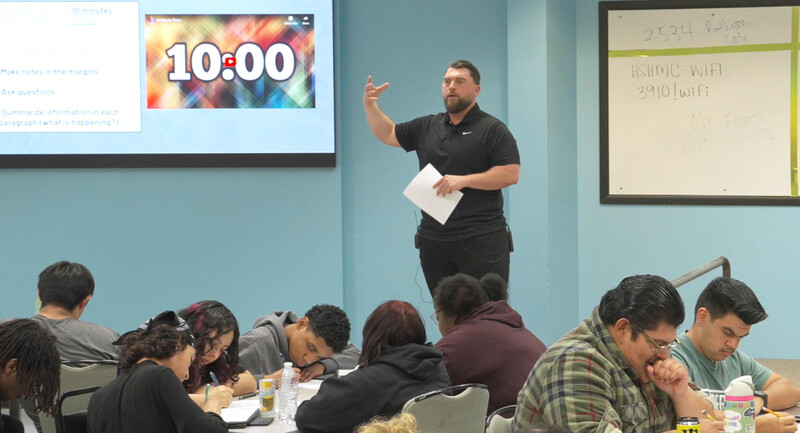In The New York Times crossword from August 15, 2021, the clue for 61 Down reads: Time-consuming assignment to grade. Five letters.
Ask any English teacher in any district across the county and you’ll hear the answer immediately: ESSAY! If The New York Times knows that grading writing is an unmanageable task, why haven’t we solved that puzzle?
The problem of grading essays can’t be fixed by productivity apps or time-management techniques. It’s not about computer adapted technology or creating more interesting assignments. In fact, many teachers already know the research stating that feedback, when focused and timely, is a crucial driver of student learning (Wiggins, 2012; Hattie & Timperley, 2007). However, when it comes to giving feedback, where is the time? Reading, grading, and planning how students revise can be a lengthy process. From a student perspective, the typical delay between writing an essay and receiving feedback can often be weeks or even longer. A teenager’s attention span is minimal—we’re lucky if they can remember what they read last week!
What we need is a systems approach to addressing not only the time needed to read and offer feedback, but also the routines and structures that guide student writers and help them improve. We need a system that is efficient for teachers, makes lessons more effective for learning, and allows students to take ownership of their writing.
Understanding Feedback Systems
A feedback system is a predictable cycle built on the principles of deliberate practice (Ericsson, 2016), designed to give students regular, structured opportunities to write and revise using feedback from their teacher. This kind of system comprises the following key student steps: (1) writing, (2) receiving feedback, (3) revising the writing based on feedback, and then (4) reflecting and setting a goal for the next week’s writing.
In a true feedback system, rather than producing long, polished pieces at the end of a unit or term, students write shorter, lower-stakes pieces regularly (every one to two weeks, ideally), receive feedback, and revise in class. Students’ focus is not on perfecting an assignment, but on improving writing over time, through practice, revision, and goal setting.
For a system like this to work, students need to receive feedback that is both timely, so that their ideas and thought processes are still fresh, and actionable, with clear steps and strategies students can take to improve.
To maximize both the effectiveness and efficiency of their feedback, teachers can create a set of feedback codes. A code is a symbol, indicating an area for growth within a piece of writing for the student to improve upon during revision time. For example, a student might look through a recently graded essay and see R1 and C2 written in the margins. A quick check of the codes list reminds her that R1 means “Reasoning needs more explanation” and C2 means “Claim/thesis is missing.” The student then knows to focus her in-class revision time on addressing those trouble areas in her work.
Here’s what a feedback system could look like:
On a regular basis (every week or every other week), students compose a short, on-demand writing piece, possibly part of a more comprehensive quiz.
The teacher grades the quiz and gives individualized, specific feedback using her set of feedback codes.
Within one to two days of the quiz, students receive their graded work back and spend time in class revising their writing.
Students reflect on their feedback and revisions and set a goal for the following week.
The following week, students get their quiz back with a final grade, review their goals for this week’s writing, and take the new quiz.
This routine gives students a predictable structure for using feedback to revise the previous day’s work, reflect on the changes they have made, and set a goal for the future (see fig. 1). Over time, the system also allows students to see how the skills they are practicing transfer to their writing in general.
Figure 1: Writing and Revision Cycle
Why a Feedback System Is Effective for Students
Teachers know the agony of spending hours giving feedback, only to have students glance at the grade and then stick the assignment in their backpack, never to be seen or heard from again. How can a systems approach change students’ relationship with feedback?
The system builds in timely opportunities for students to process their feedback.
A feedback system builds in regular time for students to consider their feedback and respond to it. Rather than merely giving students comments and then hoping they will internalize the advice, teachers know that students are taking the time to process and reflect upon their feedback. This process works best if the feedback is provided relatively quickly.
“Getting my work back the next day is the most helpful because it’s fresh in my head, I remember it, I know what I’m looking for and I actually care about making it better,” reflected one 10th grader from a 2019 class taught by Elizabeth Peters, in interviews conducted by Julie Sloan. “To be honest, even if it’s just a week later, it just doesn’t matter to me anymore. Even when teachers give us time to redo, it’s a lot of work to even care to remember.”
We have learned that it’s not good enough to hope students reflect and remember; instead, we must give students time in class to absorb their feedback and apply it to their writing, while their original thought processes are still fresh.
Predictable feedback routines focus students’ cognitive energy on the learning itself.
When students understand the routines of feedback and revision, they can focus more of their attention on revising their writing and less time wondering what the feedback means. Keeping some structures constant—the format of the task, quick turnaround, the codes themselves, even the day of the week—helps decrease the cognitive load of the writing process and allows students to focus on improving the writing itself.
The language of codes forces students to “puzzle” independently through their feedback.
The feedback codes lead students to tackle a complex and worthwhile set of mental questions:
What does this feedback code mean?
Why does it apply to this particular situation? and
How can I make a specific revision to resolve this problem?
Instead of waiting for a conference, the student independently engages in a process that might sound like, “Hm, R1 is ‘Reasoning needs more explanation.’ What could this mean? Last time I got an R1 I tried… Maybe I can do something similar...and add…” This process of actively thinking through possible solutions and then checking them against one’s goal is the learning (Willingham, 2009). Students also often enjoy this process of “figuring it out” by owning their own work and decisions. Codes can help free teachers from the tendency to do the thinking for their students and place the responsibility— and the joy— of authentic writing and decision-making onto the student writers themselves.
When repeated regularly, the system provides opportunities for deliberate practice.
Framing instruction around the principles of deliberate practice (Ericsson, 2016) requires teachers to engineer cycles of writing and revision that:
Focus on transferable, clearly defined writing skills and goals.
Supply repeated opportunities for working “outside one’s comfort zone.”
Train students to evaluate feedback quickly and then tailor their revision efforts to the current goal.
Push students to construct mental representations of effective writing through examples and models.
Build in regular time to reflect on their feedback and update future goals.
Making Feedback Efficient and Manageable for Teachers
To make feedback systems feasible and efficient for teachers, we identified three “time chunks” to incorporate into a teacher’s routine:
Time to grade: The time dedicated for teachers to do the work of reading student writing and giving feedback.
Time to stop grading: A natural deadline for teachers to finish feedback.
Time to revise: Routine time in class for teachers to return the work and allow students to think about the feedback they receive before revising.
For many teachers, designating a specific afternoon or evening for giving feedback every week helps to counter the build-up of papers over time—and the guilt that comes with it. The system requires concentrating grading on, for example, a Thursday night, and some teachers have found it useful to block off the preceding afternoon as a regular grading session. As one teacher noted, “the big benefit is that I take very little other grading home. I don’t have the big build-up of papers hanging over my head— I have a natural deadline to get the work back to students and out of my bag.”
As the routine begins, teachers start to see the shift in their own grading mindsets occur as they realize they don’t need to give perfect feedback that will “fix” the writing, but rather to give students the next steps they need to improve. Since, within this system, the goal of student revision is not creating a flawless, polished piece but rather problem-solving a particular authentic dilemma within a piece of writing, teachers can focus their feedback on targeted areas of growth for each specific student. The revision routine supports teachers’ goal for students: to think about the feedback and puzzle through how to incorporate it.
When students understand the routines of feedback and revision, they can focus more of their attention on revising their writing and less time wondering what the feedback means.
Using a standard set of feedback codes and devoting class time for revision and reflection is not only effective for learning, but also efficient for the teacher’s grading and class planning. Rather than repeatedly writing out the same phrases (“Explain more here” or “How does this connect to your main point?” or “Unclear”) teachers can trust that a feedback code will communicate clearly to students what they need to address and think about as they revise. In essence, we can reframe grading as looking for opportunities for next-step learning. This kind of thinking frees teachers to make only a few, well-chosen comments and then move on to the next student’s writing.
And crucially, if teachers allot a weekly class period for students to process the feedback and use it to revise, they don’t need to plan an additional lesson for that day: giving feedback is class planning. From our experience, following an intensive session of writing (for students), and grading (for teachers), the predictability of the “revision day” itself creates an atmosphere that is productive and relaxed.
Why Feedback Routines Matter
If we step back from the week-to-week grind of feedback and revisions, we can see that feedback routines have far-reaching implications for both students and teachers.
Routines shape mindset.
Having a regular, predictable writing and revising routine builds the idea that becoming a writer is not about inborn skill; it’s about practice. People become better through writing and revising regularly. The codes, structures, and routine stay the same from week to week because becoming a writer is the work of building and maintaining a habit.
Codes create common language.
Common language helps teachers and students better collaborate. Teachers can use the common feedback codes when meeting with each other in teacher teams to improve their own practice, allowing them to focus less on individual writing “pet peeves” and more on common misconceptions and expectations of teenage writers. Teachers may need to ask each other, “What do we mean when we tell a student their reasoning is vague? How should we address this when we see similar patterns arise?” And students, working side by side during revisions, can see connections between their classmates’ writing and their own, for example, “Oh, you got an R1? I get those all the time. Here’s what I usually try.” The common language of codes helps support collaborative learning communities of all kinds.
Codes set common high expectations.
The codes provide a framework that depersonalizes the writing feedback students get from teachers. As one 10th grade ELA and special education teacher from Julie Sloan’s school reflected in a coaching cycle, “The idea that we are pulling from the same list for all kids, is clear and visible to students, and to us!” The consistency in the feedback codes illustrates, in concrete ways, trust. It is one thing to say a teacher has high expectations; it’s another to put them into action. The same teacher continued, “For our team, codes are not just a tool of differentiation but a tool of equity. This is the set of expectations for everyone who writes in our class, and, while I might vary and differentiate how I deploy or prioritize codes for different students, those expectations won’t change.”
No matter how earnest or how thorough our feedback for students is, it only matters if students see it, internalize it, and use it to improve their work. By constructing systems that build common feedback language between teachers and students, devote sufficient time for revisions, and encourage students to work through feedback themselves, we can reimagine the writing process and get the stacks of essays off our desks.









